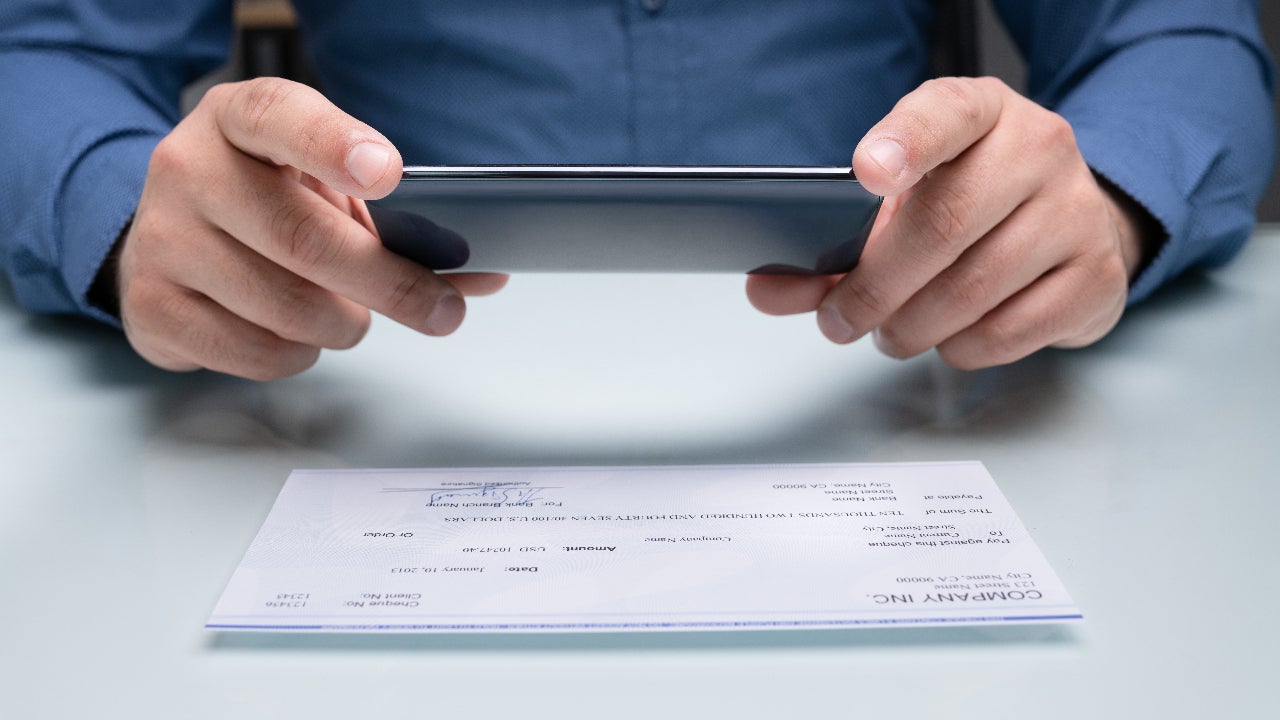Key Takeaways
- Mobile check deposit lets you deposit checks by taking photos with your smartphone instead of visiting a bank branch or ATM.
- Most major banks offer this feature through their mobile apps, including Chase, Bank of America and Capital One.
- Banks typically set daily or monthly limits on mobile deposits, often lower than in-person deposit limits.
- Always endorse your check properly and keep it for several days after depositing to avoid potential issues.
Mobile check deposit has eliminated the need to visit a branch or ATM just to deposit a check. Instead of taking time out of your day to drive to the bank, you can deposit checks anytime, anywhere using your smartphone and your bank’s mobile app.
This feature uses encrypted technology to securely process your check images, making it both safe and easy to use. Whether you receive checks for work, gifts or other payments, mobile deposit makes managing them simple. Here’s everything you need to know about using mobile check deposit effectively and safely.
What is mobile check deposit?
Mobile check deposit, also known as remote deposit capture in banking terms, allows you to deposit checks using your smartphone’s camera instead of physically bringing them to a bank. You simply take photos of both sides of the check through your bank’s mobile app, and the deposit is processed electronically.
The technology works by capturing high-quality images of your check, which are then encrypted and transmitted securely to your bank for processing. The bank’s systems verify the check information and add the funds to your account, typically within one to two business days.
Most major banks and credit unions now offer this feature as part of their mobile banking apps. This includes large institutions like Chase Bank, Bank of America, Capital One and Wells Fargo, as well as many smaller banks and online-only institutions.
You can typically use mobile deposit for both checking and savings accounts, though some banks may limit which account types are eligible for this service.
Learn more: How to choose a bank with the best mobile banking features.
How mobile deposit works
The mobile deposit process is designed to be simple and intuitive. Here’s a step-by-step guide to ensure you deposit your check successfully.
1. Check your bank’s app requirements
Download your bank’s official mobile app from your phone’s app store, and make sure you’re logged into your account. To avoid fraudulent apps, always download from your bank’s website link or search for the exact bank name in official app stores.
2. Endorse the check properly
Before you start snapping photos, endorse the check by signing the back just as you would for any deposit. Some banks require additional endorsements like writing “For Mobile Deposit” or “For [Bank Name] Mobile Deposit Only” below your signature. Check your bank’s specific requirements to avoid processing delays.
Need more help? Check out our guide to endorsing a check.
3. Take clear photos of both sides of the check
The app will guide you to position the check within the frame and ensure proper lighting. Use a dark background to help the check details stand out clearly in the photos.
4. Review and submit
Submit your deposit by confirming the amount and account selection. Double check that the dollar amount you entered matches what’s written on the check to avoid processing errors.
Most banks provide immediate confirmation that your deposit was received, though the funds may not be available immediately depending on your bank’s hold policies.
Find banks with the best mobile deposit features by comparing Bankrate’s top checking accounts that offe digital banking capabilities.
Understanding mobile deposit limits and timing
Banks implement various limits and timing policies for mobile deposits that differ from in-person transactions.
Daily and monthly limits
Limits are common restrictions that vary significantly by bank and account type. These limits are typically lower than what you can deposit in person or at ATMs. For example, many banks set daily mobile deposit limits between $2,000 and $5,000, though some offer higher limits for established customers.
Processing timeframes vary
Processing timeframes usually range from one to two business days, similar to regular check deposits. However, cutoff times for mobile deposits may be earlier than for in-person deposits. Checks deposited after the cutoff time typically aren’t processed until the next business day.
Fund availability may be delayed
Fund availability may be delayed even after you receive deposit confirmation. Banks can place holds on mobile deposits just like regular checks, especially for larger amounts or if you’re a new customer. The hold duration depends on factors like the check amount, your account history, and the issuing bank.
Common bank-specific limits include:
- Bank of America: Typically $10,000 per day for mobile deposits
- Chase: Usually $2,000 per day for most customers
- Wells Fargo: Generally $2,500 per day for standard accounts
Contact your specific bank to confirm your current mobile deposit limits, as they can vary based on your account type and banking history.
Best practices for using mobile deposits
Mobile check deposits are easy and secure, and following a few best practices can give you even more peace of mind. Here are our top tips:
- Verify app authenticity before downloading any banking app. Apple reported blocking over 47,000 fraudulent apps in just one year between May 2023 and 2024. Always download banking apps directly from links on your bank’s official website or by searching for the exact bank name in official app stores.
- Keep the physical check for several days after mobile deposit. “Hang on to the check until you see it clear and move from pending to approved on your online statement,” says financial advisor Michael Foguth, president and founder of Foguth Financial Group. Wells Fargo recommends keeping checks for five days to address any potential processing questions.
- Use secure networks for mobile deposits. Avoid public Wi-Fi networks and stick to trusted connections like your home Wi-Fi or your phone’s cellular data connection. Public networks can potentially expose your banking information to security risks.
- Delete any photos you might have taken outside the banking app. If you accidentally photographed the check using your regular camera app, delete those images immediately. Banking apps store deposit images securely on encrypted servers, but regular photo storage isn’t designed for sensitive financial information.
Bottom line
Taking advantage of the mobile deposit feature through a bank’s app can save you time and a trip to a branch. Be sure that the amount you deposit doesn’t exceed the bank’s limit and hold onto any check for a few days after submitting it.
If your current account doesn’t offer this feature, it may be worth researching checking accounts to find one that comes with mobile check deposit and other helpful digital banking features.
Why we ask for feedback
Your feedback helps us improve our content and services. It takes less than a minute to
complete.
Your responses are anonymous and will only be used for improving our website.
Help us improve our content
Read the full article here
















